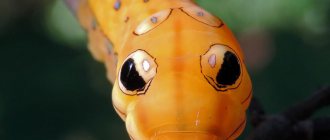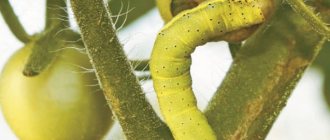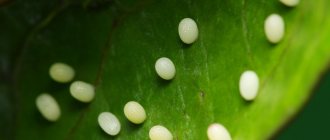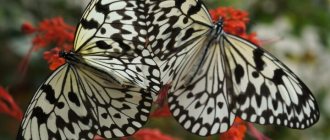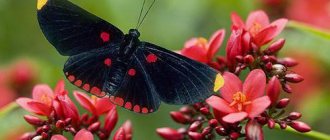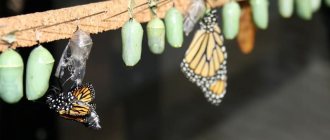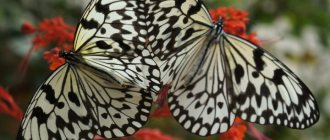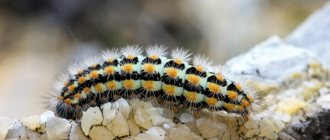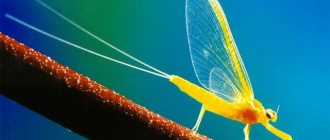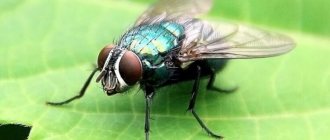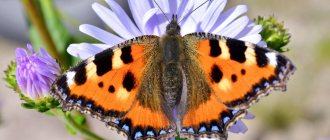Price: 900 rubles
Morpho is an iridescent tropical butterfly. The brilliant blue color of the wings is caused by the diffraction of light from the millions of tiny scales on her wings. She uses this to scare off predators by quickly flaring her wings. The wingspan of the blue morph ranges from 7.5 to 20 cm. Morpho is considered one of the most beautiful butterflies in the world and there is no doubt about it. During flight, its wings shimmer with a metallic sheen, changing their color depending on the angle of incidence of light, from soft blue to dark blue-green.
Morpho is a genus of diurnal butterflies native to Central and South America. The total number of species is about 80.
The butterflies apparently owe their strange name to the ancient Greeks. Translated from their language, the word morpha means “beautiful.” Indeed, among insects they have practically no equal in their unsurpassed range of shades.
Morpho.
Glass Butterfly (Greta Oto)
The glass butterfly (Greta oto) is found in Central and North America and is known for its long-distance migrations.
It is typically found in Mexico and Colombia, but migrates to Florida in search of food. The butterfly got its name from its transparent wings with brown or black edges. This makes it difficult for predators to detect this butterfly, especially at long distances. In Mexico she is also called Greta Oto. The insect feeds on a common species of flowering plant called Lantana. The glass butterfly is also one of the most transparent living creatures on the planet. If we talk about appearance, the internal and external colors of the wings are strikingly different. The outer colored part of the wings is less attractive compared to the inner one. The tops of the wings are dusty gray with a few blue and orange dots, and the insides look like iridescent soffits. Its unique coloration makes it one of the most beautiful butterflies in the world.
The most beautiful butterflies
It is impossible to give a single answer to the question of which butterfly is the most beautiful. Each of them is unique and good in its own way. But, of course, a surprise gift in the form of bright, colorful butterflies can fill the room with magic! You can select and buy butterflies at low prices on this website with delivery throughout Moscow. Such a gift will be unforgettable! I wonder which butterflies are regularly included in lists of the most beautiful? Below will be presented the most beautiful butterflies in the world with names, as well as photos of beautiful rare butterflies.
Butterfly Prince
This insect is considered the largest nocturnal butterfly. Its front wings are curved in such a way that they imitate the head of a snake, which scares away enemies. This natural feature allows the insect to survive. This coloring of a butterfly, of course, does not frighten a person, but rather delights it. Indeed, how inventive nature can be!
The peculiarity of these butterflies is that their oral apparatus is not at all developed. “How do they eat?” - many will think. The thing is that they live only one or two weeks and exist thanks to the processing of fat reserves accumulated in the cocoon.
Another name for the Prince butterfly is Atlas Peacock-Eyes
Butterfly Birdwing
This butterfly also reaches large sizes, but it is active during the day, which is why it is called diurnal. The insect received such an interesting name due to its amplitude, bird-like wingspan, which can reach 32 cm. The birdwing is considered one of the rarest species of butterflies. He lives only in the small town of New Guinea. Because of this, the Birdwing is a prized specimen for many collectors. The wings of the male Birdwing shine in blue and green, even looking somewhat reminiscent of the leaves of tropical plants. But the females are less bright, their wings are colored black, cream and yellowish.
Another name for this butterfly is Queen Alexandra's Birdwing, named after the wife of the English king Edward VII.
Butterfly Urania
This colorful tropical butterfly lives in Madagascar. Urania has a truly wondrous coloring. Individual sections of the wings are painted black with pigment, with colorless scales running between them. These scales refract light, making butterflies appear colorful and change color depending on the angle at which you look at them. The Madagascan Urania's coloration is dominated by orange, red and purple. Interestingly, the pattern on the wings may not be symmetrical, which is due to the influence of external factors at the pupal stage.
Urania was recognized as the most beautiful by the international scientific congress
Butterfly Greta
Translated into Russian, the name of this butterfly sounds like “glass.” This name is absolutely justified, because its wings are transparent, as if made of glass, and only bordered on the periphery with a black-brown ribbon. This insect is found in Central and South America. It is believed that the butterfly is very common in this region, but it is not at all easy to spot, because it is almost transparent. This is an excellent camouflage that allows butterflies to hide from predators.
The Greta Oto butterfly is poisonous to predators, so no one rushes to feast on it.
Callima butterfly
Callima can be found in the tropics of Asia and Africa. This type of butterfly is primarily interesting for the unusual contour of its wings. The upper wings of butterflies are painted in stripes of black, orange and blue, flowing harmoniously into each other. But as bright as they are during the flight, they become so invisible when they sit on the foliage and fold their wings. The thing is that the back surface of the wings is painted greenish, which allows Callimas to camouflage themselves so successfully under foliage.
Callima butterflies are also called leaf butterflies. Its folded wings resemble the contours of a leaf.
Butterfly Parides Arcas
These are butterflies from the swallowtail family, medium in size. The body and wings of the insect are black, with scarlet and blue spots. These are very active butterflies that will fly around the room, and when they sit down somewhere, they will continue to open and close their wings. Amazing, fragile creatures that can captivate anyone with their beauty!
This butterfly is distributed from Mexico to Peru
Blue Morpho Butterfly
This butterfly is of medium size, its wingspan is usually no more than fifteen millimeters. But she captivated people not with these parameters, but with her amazing beauty. The wing scales are arranged in a special way, reflecting the sun's rays, giving the impression that the butterfly is all glowing. When the insect sits, its wings appear to be a rich blue color with a black border. But in fact, this is not the true color of the butterfly, but a trick of light. When the butterfly flies, it shimmers under the sun's rays with different colors, sometimes purple, sometimes greenish. Such an amazing blue Morpho butterfly.
Another name for this butterfly is the morpho Peleida butterfly, in honor of the Greek hero, the son of Peleia and Thetis
Butterfly Peacock Eye
Peacock's Eye lives in Europe, as well as the subtropical zone of Eurasia. They are especially common in Germany. As you might guess, this species of butterfly received its name due to its external resemblance to the coloring of peacock feathers. The body of the butterfly is painted black. But the wings are colored orange-brown with characteristic blue colored spots and eyes. Miracle peacock butterfly!
The Latin name of this butterfly Inachis io comes from the names of King Inach and daughter Io - heroes of ancient Greek mythology.
Sailboat Maak
This butterfly is also called the Blue Swallowtail. In the male, most of the forewing is represented by green, even emerald, pollination. Part of the wing shimmers deep black. The females of the Maak Swallowtail have more varied colors; it is even believed that no two butterflies are alike in the world. This is a fairly large daytime butterfly; the size of its wings can reach thirteen centimeters.
This is the largest diurnal butterfly found on the territory of the Russian Federation
Butterfly Hypolimnas bolina
Hypoliminas bolina live in Southeast Asia, as well as Australia. These small butterflies are often called tiara butterflies because of the vibrant blue, red and white hues of their wings, like diamonds shimmering in a crown. If you look at the butterfly from above, its wings are black, lighter along the outer edge. Males have white spots on their wings that turn purple when exposed to sunlight.
The Hypolimnas bolina butterfly is also called the moon butterfly.
Can you buy dolls?
But it is much more interesting to watch how the winged beauty emerges from the chrysalis. To do this, you can purchase a turnkey kit, which includes:
- Butterfly garden (house for dolls).
- Pupae.
- Growing instructions.
A butterfly pot is a glass container into which pebbles are placed at the bottom and water is poured. Inside there is a stick to which the pupae are attached. It's all covered with breathable fabric.
If all conditions are met, butterflies will appear within 2 weeks. They can fly freely around the apartment. However, remember that other pets and open windows are a direct threat to their existence.
Apollo
Apollo (Parnassius apollo) is an extremely rare species of butterfly. It is found only in parts of Italy, France and Spain and is currently endangered. He has very beautiful shimmering silver wings. The forewings have black spots, and the hindwings have larger red and black spots called "eyespots". The larvae of this butterfly have excellent colors, which help camouflage themselves from predators. Adults use large spots on their wings and a foul-smelling substance to scare away predators.
The red and black spots on the hind wings can vary in size and shape depending on their location on the butterfly's wings. The bright color also fades in the sun, causing the red spot to appear orange in older butterflies. The edges of the wings are slightly transparent, which gives the butterfly additional charm.
Behavior
The tropical morphopeloid butterfly is active during daylight hours. Adults feed on the juice of spoiled fruits, pollen and nectar. They especially like sweet bananas that are starting to rot.
They fly over open forested areas along paths, rivers and lakes. Their zigzag flight is fast and powerful, with females most active in the air around midday. The rapid flapping of the wings resembles blue lights against a background of monotonous greenery.
Natural enemies of these insects include the red-tailed jacamara (Galbula ruficauda) and birds from the flycatcher family (Muscicapidae).
Features of morpho behavior
It should be noted that morphos are rather inactive: females sit quietly on branches most of the time, and males devote no more than a couple of hours a day to active flight. Interestingly, different species have active periods at different times of the day, so different species of butterflies do not compete with each other. But during the flight they behave very playfully, more than compensating for lazy rest.
Morphos of each species fly at certain times of the day, and the duration of daily activity does not exceed two hours.
It has been noted that morphos have territorial behavior: males can actively pursue other butterflies, including white butterflies, unrelated to them.
Angel Sylphina
This beautiful butterfly is found in some countries of South America: Bolivia, Ecuador and Peru. Like the glass butterfly, the sylphina butterfly (Chorinea sylphina) has mostly transparent wings with black edges. The lower part of the wing has red and white stripes. Sylphina lives only in forests growing at significant altitudes. She prefers not to fly without bright sunlight. Usually these insects fly alone in search of food, but sometimes they gather in groups of several hundred individuals. In the spring, they also migrate to areas more than 300 kilometers away in search of food.
Popular articles Minor repairs of felted items
This beautiful butterfly can lay up to 150 pink eggs at a time. The caterpillars crawl throughout the plant until each one has its own leaf. When the caterpillars mature, they create a chrysalis from their leaf. Adult butterflies drink flower nectar. The butterfly's lifespan is less than 9 months.
Blueberry - a day butterfly with an unusual color
The diversity of the world's fauna is expanding with thousands of different species of butterflies, both large and small, both bright and dark. Many legends and beliefs are associated with these wonderful insects, for example, in ancient times, the Slavs treated butterflies with respect, because they thought that they were the souls of the dead. But the topic of today’s article will be the blueberry butterfly , a fairly common species among the steppes and tropics.
Reproduction
Morphopeleid butterflies breed all year round. After mating, the female lays one egg at a time on the undersides of the leaves of tropical legume plants. Most often these are Pterocarpus, Lonchocarpus, Andira, Swartzia and Dalbergia.
The caterpillars hatched from the eggs are very thin, reddish-brown in color with yellow or light green spots. They grow quickly and undergo 5 molts before pupation, growing up to 90 mm.
The color of the pupae can be green in a variety of shades. The thorns with which they are attached to the branches upside down are clearly visible in their lower part.
Reproduction morpho
During the breeding season, the female morpho lays whitish translucent eggs on legume leaves.
The caterpillars that hatch from them are brown-red in color with yellow or white spots. Their body is densely covered with tufts of long hairs, which are irritating to human skin. For birds, the appearance and hairiness of the caterpillars also serves as an eloquent signal - “don’t touch me, I’m poisonous!” If this warning sign does not help, the caterpillar secretes a foul-smelling liquid that resembles rancid oil.
The bright colors of butterflies attract predators.
Over time, the caterpillar pupates. The cocoon is similar in shape and color to the fruits of those grasses, vines or trees on which the adults feed. Blue Morpho pupae produce ultrasound when touched.
Adult butterflies feed on juicy fruits and sap flowing from plants, and in places where it accumulates large accumulations of morpho can often be observed.
pet
Given the size of these lepidopterans, a large insectarium is required to maintain them. Blue morph butterflies are fed with sugar syrup and fruits, which are pre-cleaned. Feeding is carried out 1-2 times a day.
The biggest problem is maintaining humidity. If conditions are too dry, the butterfly's legs, antennae and wings will break. The optimal temperature for insect life is 23–38 degrees Celsius. In cooler conditions, butterflies become inactive and sleepy. And at a temperature of 15 degrees they generally die.
The average price for such butterflies in Russia is from 3 to 6 thousand rubles.
How many days do butterflies live at home?
Receiving butterflies as a gift is certainly very pleasant. But I really want these wonderful creatures to delight with their beauty for as long as possible! How many days do butterflies live at home? On average, life expectancy ranges from several days to several weeks. This of course depends on the type of butterfly, but also on their habitat conditions. How to properly care for butterflies?
At night, it is better to place the butterflies in a box with holes made. And to maintain moisture, you can put cotton wool soaked in water at the bottom of the box.
- Comfortable temperature for the existence of butterflies is +20 degrees.
- Most butterflies love moisture, so it is necessary to spray the insect with a spray bottle several times a day. It is enough to make one or two presses at a distance of 20-30 centimeters.
- Butterflies can fly around the room and land wherever it is convenient for them. But if you want to take it, take it by the body, at the base of the wings. Remember, these are very fragile creatures.
- Butterflies feed on sugar syrup, crushed bananas or citrus fruits. It is enough to feed the butterfly once a day. To do this, carefully grab the insect by the body and place it with its paws on the edge of the saucer with the prepared treat. When the butterfly senses a treat, it will straighten its proboscis and begin to eat.
By following these simple recommendations, you can extend the life of these divine creatures, which means they will delight you with their beauty and tenderness even longer!
Description of the species
Morphodidius are butterflies belonging to the genus Morpho, of the Nymphalidae family. Various scientists include 30-60 species of butterflies in the genus. Morphodidius is one of the largest representatives of the group, with a wingspan of 135-160 mm. The outer edge of the front wings has a protrusion, and there are serrations along the entire perimeter.
The color of the wings is a rich blue color with a violet, pearlescent or green tint. When viewed from different angles, the shades of the wings change. The incredible metallic shine and radiance of the butterfly's color is due to the special structure of its scales. The most common form of coloration is an azure blue background with brown edging along the edge of the wings. There are individuals of purple, emerald or blue hue. The reverse side of the wings is brown. Ocellated spots and light bands are scattered across the main background. The protective coloration allows butterflies that spend a lot of time on trees to remain unnoticed. The wings folded behind the back disguise the didius as a dry leaf.
The butterfly's body is divided into 3 main sections: head, chest and abdomen. The eyes are large, protruding, occupying most of the head. The morpho's organs of vision are sensitive to ultraviolet radiation; males notice each other at a considerable distance. The filamentous antennae are dark and serve as olfactory organs. Insects feed using a long proboscis. Two pairs of wings and three pairs of walking-type legs are attached to the thoracic region. The forelimbs are reduced, which is a characteristic feature of representatives of the nymphalidae family.
Sexual dimorphism
In tropical butterflies of the genus Morpho, sexual differences are noticeable. Males are bright blue with a metallic sheen. The wings of females lack a pearlescent sheen; along the edge there is a wide brown stripe, often with white spots. Males are more active, although this quality often turns against them. Butterfly catchers wave blue scarves to attract male morphos.
Popular articles Macaroni tea set
Features of the structure of scales
The refraction of light rays on the plates causes a rainbow-colored glow, this optical effect is called iridescence. The blue color is created not by pigmentation, but by the reflection of light from the pyramidal scales. The lower part of the scales has a color that does not transmit light, which gives additional brightness. The beam is reflected from the outer and inner surfaces of the scale, creating two reflections that reinforce each other.
So colorful
At different angles of incident light, the wings of this butterfly can be bright blue, cyan and even green. This effect is achieved thanks to lens-shaped scales that cover the entire surface. The upper part is transparent, and the lower part contains the pigment melanin. Light passes through the transparent part, and then is reflected from the colored part and refracted many times (interference effect). This is how the metallic shine of a butterfly’s wings and its unusually beautiful color arise. And if an insect folds them, it can simply disappear from view, and then appear out of nowhere.
Butterflies and people
In nature, this species has no economic significance. Local Indians have long used butterfly wings to decorate masks. Today they are used to make jewelry.
But most of all, they found application in satisfying human aesthetic needs. They are kept in insectariums and bred for holidays and unusual gifts. And what wonderful photographs they take! But the most beautiful pictures are obtained when butterflies are collected in groups. There is nothing surprising about this.
During periods of drought, they can gather in groups on damp ground or on tree trunks. The well-known episode from the series “Bones”, in which butterflies sat at the burial site of a corpse, is thus completely understandable.
The meaning of morpho butterflies for humans
These butterflies have no economic importance, but their bright appearance makes the morphos very popular among collectors. Images of these insects can be seen in photographs, design elements, and the morphos themselves are often kept in special insectariums.
Flocks of morpho butterflies feeding on the sweet sap of a tree.
Leaf Butterfly (Kalima)
The leaf butterfly (Kallima) is so named because of its original method of camouflage. She has brown wings with an irregular pattern that resembles a yellowed leaf. They are characterized by yellowed spots and jagged edges. The upper side of the wings is usually bright, but the lower side is dull and inconspicuous. Butterflies open their wings to reveal a pattern to find a mate during mating season. When folded, the wings are difficult to distinguish from a yellowed leaf.
This insect is found in forests throughout Asia. It is also known as the Indian leaf butterfly. These butterflies cannot fly quickly over long distances and prefer to stay in one place unless they feel threatened. Their diet mainly consists of nectar from flowers and fruits.
Which of these butterflies have you seen? The next time you go to a park or country house, be sure to pay attention to the beautiful butterflies that live there. Of course, you must take a photo and share it with friends. . What is no less amazing is the path that every butterfly goes through - from an inconspicuous caterpillar to a beautiful creature fluttering under the clouds
This transformation process has served as an inspiration for artists and writers around the world
What is no less amazing is the path that each butterfly goes through - from an inconspicuous caterpillar to a beautiful creature fluttering under the clouds. This process of transformation has been a source of inspiration for artists and writers around the world.
The blue glow of related satyrs
Catching morpho is not an easy task. These butterflies fly very high.
There are two ways to catch:
- or they are lured by the shine of the wings of the same butterflies,
- or build towers and platforms on the tops of flowering trees,
and from there they catch morphos with nets on long sticks.
The most spectacular butterfly is the morpho-retenor. It is dark blue, like the water of the southern sea. A little lighter - menelaus. And there is a silver-blue morpho. This is Eugenia, flying in the early morning twilight.
Morphos are relatives of our humble brown satyr butterflies. And indeed; when some satyrs, basking in the sun, open their modest little wings, I have more than once noticed a blue glow on them.
Reproduction and development
Morphologically inactive insects, they spend most of their time sitting quietly on tree branches. Females prefer the upper tier of the forest. Males live in the grass. They are more active, but their active years take no more than two hours a day. Insects feed on the nectar of flowers, but the basis of their diet is fruit juice. The fermented sap of trees and tropical fruits is of particular interest to them. Morphos need microelements for their life; to replenish them, insects flock to moist mineral soil.
The lifespan of butterflies is 3-4 months. The bulk of the time is spent on feeding and reproduction. Females lay greenish eggs on the leaves of food plants. Caterpillars develop on tropical types of legumes: peanuts, mucuna pruriens. The body of the caterpillars is reddish-brown with yellow spots. The large head is covered with bristles. There are tufts of pinkish hairs on the body. They are poisonous to predators and can cause irritation to humans. In addition, caterpillars are capable of secreting liquid with an unpleasant odor.
Popular articles Rainbow in a glass.
The pupa is green, hung upside down. In appearance it resembles the fruit of a legume plant. The duration of the stage is 20-30 days. The pupae are often exported to various countries for captive breeding of the beautiful Morpho didius butterflies.
What are they eating
These diurnal butterflies in their natural habitat feed on rotting fruits, the sap of flowers and trees. They are not averse to feasting on rotting remains of animal origin. When kept in captivity, the diet consists of rotted fruits and a honey solution.
Caterpillars feed on foliage and eat plants of the legume family well. Development from egg to adult (adult butterfly) lasts about 2.5 months. In nature, insects live up to six months. In captivity, with good care - up to 2.5 months.
Spreading
The habitat is located in Central America and adjacent territories in the south and north of the American continent. The largest populations are found in Mexico, Paraguay, Venezuela and Colombia. In Brazil, the butterfly is common in the north of the country.
It is also found on many islands of the Caribbean, Costa Rica, El Salvador and Trinidad. The insect lives mainly in rain-plain forests. In mountainous areas it has been seen at altitudes up to 1400 m above sea level.
To date, 4 subspecies are known. The nominate subspecies is distributed in Mexico. In many Latin American countries, peleids are bred on special farms. Their pupae are exported mainly to the USA and EU.
General information
The blue morph butterfly (Morpho peleides Kollar) is a representative of insects of the order Lepidoptera of the Nymphalidae family. These insects received their name in honor of the ancient Greek hero Achilles Peleid, who was famous, among other things, for his beauty. From the ancient Greek language morpho means “beautiful”. And in the butterfly’s homeland, in the tropical forests of Central and South America, they are called “particles of the sky that fell to the ground.” Indians believe that blue morphs are the souls of deceased ancestors who strive upward.
These are diurnal butterflies with a wingspan of up to 15 centimeters. They owe their extraordinary blue color to the optical effect of light refraction in the scales that cover the surface. There are light bands along the edges of the wing. On the underside they are brown-brown. The oral apparatus is of a sucking type with a pronounced proboscis.
Representatives of the blue morph (there is a photo in the article) have pronounced sexual dimorphism. Males are larger, with more pronounced wing coloration.
Caterpillars are pubescent. They are painted in a complex pattern of brown, purple, yellow, black, white spots or streaks. The pupae are green and teardrop-shaped.
Appearance of morpho
Representatives of morpho are distinguished by their large size: the wingspan of even the smallest individuals is approximately 5 cm, and the largest, morpho Hecuba, is 21 cm. This alone makes them expressive in their natural habitat.
But the main secret of the beauty of morpho butterflies is the special structure of their scales, each of which has the shape of a lens. It is characteristic that the upper surface of each scale is transparent and freely transmits light, while the lower surface, thanks to the melanin pigment, is darkened and therefore reflects light like a mirror. On the way back, the light is refracted at different angles and, as it were, “split” (in physics this is called interference, and we call this phenomenon a rainbow).
Morphos exhibit sexual dimorphism: females of many species are colored shades of yellow with gray-brown spots.
Because of these lighting effects, the butterfly's wings have a metallic sheen that fades in and out depending on the angle at which we see the insect. It is not surprising that in the forest bright morphos suddenly disappear from view, for example, sitting on a branch.
The color of the morpho is dominated by sapphire blue, blue and violet tones, which are the most characteristic of this genus of butterflies. But the natural color of the wings, not associated with optical effects, is most often brown. In males, the underside of the wings is colored with it, and in females, the upper surface of the wing may also be brown.
